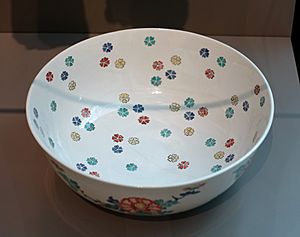Salad bowl facts for kids
A salad bowl is a special bowl used to serve salads. It's often used for "tossed salads," which are salads where all the ingredients are mixed together. Think of it as a big, wide dish perfect for sharing your favorite salad with friends and family!
Contents
What are Salad Bowls Made Of?
Salad bowls can be made from many different materials. These include ceramics (like pottery), metal, plastic, glass, or wood. Each material has its own look and feel.
Wooden Salad Bowls: A Popular Trend
From the 1940s to the 1960s in the United States, wooden salad bowls became very popular. Many cookbooks suggested using them. This trend started thanks to a famous food writer named George Rector. In 1936, he wrote an article called "Salad Daze."
Rector suggested using a wooden salad bowl that wasn't shiny or varnished. He said this was a French tradition. He also gave some interesting advice:
- Rub garlic into the bowl to give salads a hint of garlic flavor.
- Oil the bowl regularly to keep the wood nice.
- Never wash the bowl with soap and water!
Rector believed that over time, the wood would soak up the oil and garlic flavors. He said it would become more beautiful and unique, like an old piece of art or a special antique.
By Christmas that year, wooden salad bowls were a very fashionable gift. By 1949, a writer named Russell Lynes even joked that a very sophisticated person "wouldn't dream of washing his salad bowl."
Why Not Washing Wooden Bowls Was a Bad Idea
Even though it was a popular idea, not washing wooden salad bowls had problems. Experts soon pointed out that it wasn't a good idea.
- Cheap or poorly made bowls could crack.
- Oil and food bits could get stuck in these cracks.
- Over time, these bits could go bad and make the bowl smell unpleasant.
- The strong garlic smell could become too much, instead of just a hint.
So, while the idea of a "seasoned" wooden bowl sounded cool, it wasn't always the best for hygiene or freshness!
How Salad Bowls Are Used
Rubbing garlic on a salad bowl has been a tradition for a long time. Even before George Rector, people were doing this. For example, a French book from 1815 mentioned rubbing the salad bowl with garlic. An American cookbook from 1926 also suggested it in many recipes. This shows that people have long enjoyed adding a subtle garlic flavor to their salads directly from the bowl!
Different Shapes and Sizes
Salad bowls come in all sorts of shapes and sizes. Some are very flat and wide, while others are tall and deep. You can find them in many designs to fit any kitchen or dining table!


